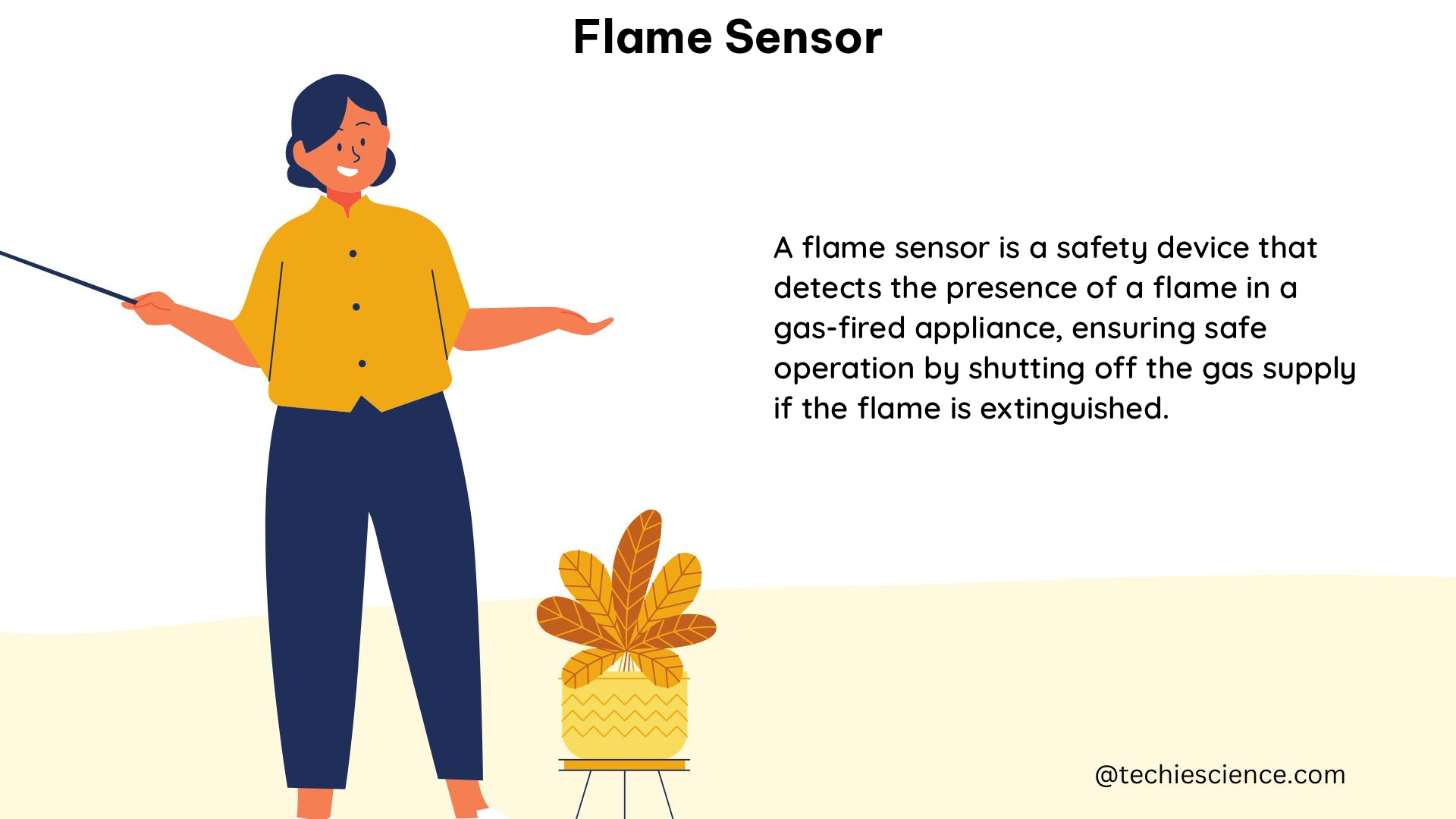Flame sensors are crucial components in various systems, including boilers and furnaces, where they ensure the presence of a flame during combustion. These sensors detect the flame by measuring the voltage that converts to a DC voltage when the flame rod is inserted into a proper flame. This DC voltage is typically in the range of microamps (µA).
Understanding the Fundamentals of Flame Sensors
The Principle of Flame Rectification
The flame sensor’s ability to detect the presence of a flame is based on the principle of flame rectification. When a flame is present, the flame’s ionized gases allow the AC voltage applied to the flame rod to flow in one direction, effectively converting the AC signal to a DC signal. This process is known as rectification.
The flame’s ability to rectify the AC voltage is due to the presence of charged particles, such as electrons and ions, within the flame. These charged particles are generated through the combustion process and act as charge carriers, allowing the current to flow in a specific direction.
The flame sensor measures the DC current generated by this rectification process, which is typically in the range of 1-2 microamps (µA) when a flame is present. This measurable DC current is the key indicator that the flame sensor uses to detect the presence of a flame.
The Flame Sensor Circuit
The flame sensor circuit consists of a flame rod, a sensing circuit, and a control board. The flame rod is inserted into the flame, and the sensing circuit measures the DC current generated by the flame rectification process. The control board then interprets this signal and determines whether a flame is present or not.
The sensing circuit typically includes a resistor and a capacitor, which form a simple RC (Resistor-Capacitor) circuit. The resistor converts the small DC current from the flame rod into a measurable voltage, while the capacitor filters out any AC components that may be present.
The control board, which is often part of the boiler or furnace’s main control system, receives the voltage signal from the sensing circuit and compares it to a predetermined threshold. If the voltage signal is above the threshold, the control board recognizes the presence of a flame and allows the system to continue operating. If the voltage signal falls below the threshold, the control board interprets this as a lack of flame and takes appropriate action, such as shutting off the fuel supply to prevent a dangerous situation.
Factors Affecting Flame Sensor Performance
Several factors can influence the performance and reliability of a flame sensor, including:
-
Flame Characteristics: The size, shape, and intensity of the flame can affect the strength of the rectified DC signal. Larger, hotter flames typically produce a stronger signal, while smaller or weaker flames may result in a weaker signal.
-
Sensor Positioning: The placement of the flame sensor relative to the flame is crucial. The sensor must be positioned in a way that allows it to accurately detect the flame’s presence and strength.
-
Sensor Cleanliness: Over time, the flame sensor can become coated with soot, dust, or other contaminants, which can reduce the sensor’s ability to detect the flame. Regular cleaning of the sensor is essential to maintain its performance.
-
Electrical Interference: Nearby electrical equipment or wiring can introduce electrical noise or interference, which can affect the sensor’s ability to accurately measure the flame’s rectified DC signal.
-
Sensor Degradation: Like any electronic component, flame sensors can degrade over time due to factors such as heat, vibration, and age. This can lead to a gradual decrease in the sensor’s sensitivity and reliability.
Measuring and Interpreting Flame Sensor Signals

Flame Sensor Output Characteristics
As mentioned earlier, a properly functioning flame sensor should ideally output a DC current of 1-2 microamps (µA) when a flame is present. This current is generated due to the flame’s ability to rectify the AC voltage applied to the flame rod.
When no flame is present, the flame sensor should detect a potential at the rod but no current. This indicates that the AC voltage is not being rectified, and there is no flame present.
Once a flame is introduced, the small microamp DC current is generated, signaling the control board that a flame exists, and the system can continue operating safely.
Measuring Flame Sensor Output
To measure the flame sensor’s output, you can use a multimeter or a specialized combustion analyzer. The multimeter should be set to measure DC current in the microamp (µA) range.
To take the measurement, follow these steps:
- Ensure that the flame sensor is properly installed and the system is operating with a flame present.
- Locate the flame sensor’s wiring and identify the terminals or connections that carry the DC signal.
- Connect the multimeter’s positive lead to the flame sensor’s signal terminal and the negative lead to the ground or common terminal.
- Observe the multimeter’s reading, which should be in the range of 1-2 microamps (µA) when a flame is present.
If the reading is below 5 microamps (µA), it is likely that the flame sensor is dirty and needs to be cleaned.
Cleaning and Maintaining Flame Sensors
Over time, the flame sensor can become coated with soot, dust, or other contaminants, which can reduce its ability to detect the flame accurately. To maintain the sensor’s performance, it is essential to clean it regularly.
The recommended cleaning method is to use a 3M Scotchbrite pad or a similar abrasive cleaning pad. Gently rub the flame rod with the pad to remove any buildup or deposits. Be careful not to damage the rod or the sensor’s housing during the cleaning process.
After cleaning, reinsert the flame sensor and check the output again. If the reading is still below 5 microamps (µA), the sensor may need to be replaced.
It is important to note that the specific cleaning and maintenance procedures may vary depending on the manufacturer’s recommendations. Always refer to the manufacturer’s instructions for the proper maintenance and care of the flame sensor.
Advanced Flame Sensor Techniques and Applications
Flame Sensor Diagnostics
In addition to measuring the flame sensor’s output, you can perform more advanced diagnostics to identify potential issues with the sensor or the overall system.
One such diagnostic technique is to measure the flame signal voltage. This voltage is typically in the range of 0.5 to 5 volts DC and can provide additional information about the flame’s strength and stability.
Another diagnostic tool is the use of a combustion analyzer, which can measure various parameters related to the combustion process, such as oxygen levels, carbon monoxide (CO) levels, and flue gas temperature. By analyzing these parameters, you can gain insights into the overall performance of the flame sensor and the combustion system.
Flame Sensor Integration with Control Systems
Flame sensors are often integrated with the main control system of a boiler, furnace, or other combustion-based equipment. The control system uses the flame sensor’s signal to monitor the presence and stability of the flame, and to take appropriate actions based on the sensor’s input.
For example, if the flame sensor detects the absence of a flame, the control system may shut off the fuel supply to prevent a dangerous situation. Conversely, if the flame sensor detects a stable flame, the control system can allow the system to continue operating.
Advanced control systems may also use the flame sensor’s signal to optimize the combustion process, adjusting parameters such as fuel-air ratio, burner modulation, or ignition timing to improve efficiency and reduce emissions.
Flame Sensor Applications in Specialized Systems
Flame sensors are not limited to traditional boilers and furnaces. They are also used in a variety of specialized systems, such as:
- Industrial Burners: Flame sensors are critical in industrial burners used for process heating, drying, or other industrial applications.
- Gas Appliances: Flame sensors are found in gas-fired appliances, such as water heaters, stoves, and ovens, to ensure safe operation.
- Turbine Engines: Flame sensors are used in turbine engines to monitor the combustion process and prevent flameouts.
- Combustion Research: Flame sensors are employed in research settings to study the dynamics and characteristics of flames, such as flame stability, temperature, and emissions.
In these specialized applications, the flame sensor’s design, performance requirements, and integration with the overall system may differ from traditional residential or commercial heating systems.
Conclusion
Flame sensors are essential components in a wide range of combustion-based systems, ensuring the safe and efficient operation of these systems. By understanding the fundamental principles of flame rectification, the flame sensor circuit, and the factors affecting sensor performance, you can effectively measure, interpret, and maintain flame sensors in various applications.
The comprehensive guide provided in this article covers the technical details, diagnostic techniques, and advanced applications of flame sensors, equipping you with the knowledge and tools necessary to work with these critical components in the field of science and engineering.
References:
- Measuring Flame Signal & Cleaning Flame Sensors
- Flame Sensing: The Basics
- Spectrometer-based combustion monitoring for flame stoichiometry and temperature control
- Flame Sensor Operation and Troubleshooting
- Flame Sensor Troubleshooting Guide

Hi, I am Sanchari Chakraborty. I have done Master’s in Electronics.
I always like to explore new inventions in the field of Electronics.
I am an eager learner, currently invested in the field of Applied Optics and Photonics. I am also an active member of SPIE (International society for optics and photonics) and OSI(Optical Society of India). My articles are aimed at bringing quality science research topics to light in a simple yet informative way. Science has been evolving since time immemorial. So, I try my bit to tap into the evolution and present it to the readers.
Let’s connect through